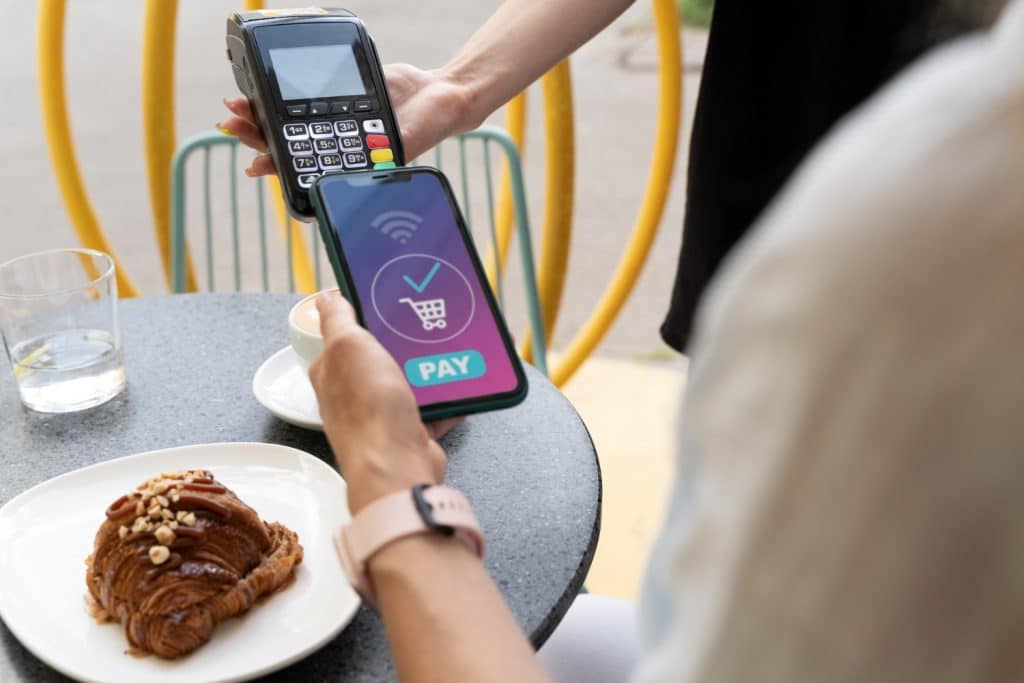Contactless payments growth in the US: A changing landscape

Anúncios
Contactless payments growth in the US is reshaping how people shop, dine, and travel. With just a tap, transactions have become faster, cleaner, and more intuitive, matching the pace of our increasingly digital lifestyles.
From bustling city cafés to suburban grocery stores, this shift is redefining the checkout experience. Consumers now expect speed and security, while businesses adapt to meet the new standard of seamless, touch-free interactions.
As this payment revolution accelerates, it’s not just about convenience, it’s about a cultural and technological transformation. The question is: are you keeping up with the change?
Anúncios
The rise of contactless payments
Contactless payments growth has become one of the most significant shifts in the US financial landscape over the past decade.
What began as a niche option for early adopters has now evolved into a mainstream habit, driven by advances in NFC (Near Field Communication) and mobile wallet technology.
Banks, payment providers, and retailers have all invested heavily in upgrading systems to accommodate this demand, creating an ecosystem where speed and convenience are no longer luxuries, they are expectations.
Anúncios
This surge reflects a broader cultural change in how Americans perceive transactions. The need for faster checkouts, combined with rising smartphone adoption and improved security protocols, has fueled widespread adoption across multiple industries.
From grocery stores and coffee shops to public transportation and entertainment venues, tap-to-pay methods are becoming the norm rather than the exception.
At its core, this trend is not just about replacing cash or swiping cards. It represents a shift toward a fully digital, frictionless payment experience that aligns with consumer behavior in a connected world.
As infrastructure improves and awareness grows, contactless payments growth shows no sign of slowing down, signaling a permanent transformation in the way people spend.
The appeal of contactless payments
The appeal of contactless payments growth lies in the perfect combination of convenience, security, and efficiency. By simply tapping a card, smartphone, or wearable device, consumers can complete transactions in seconds, bypassing the need for PIN entry or handling cash.
This streamlined process is especially valued in high-traffic locations, where speed directly impacts customer satisfaction and turnover rates.
Health and safety considerations have also played a pivotal role in accelerating adoption. During the pandemic, touch-free transactions became more than a preference, they became a necessity.
Consumers grew accustomed to minimizing physical contact at checkout counters, and this habit has persisted even as restrictions eased, reinforcing the shift toward digital-first payment solutions.
Beyond convenience, contactless payments also bring robust security features. Each transaction generates a unique, encrypted code that makes it far harder for fraudsters to intercept sensitive information.
Benefits for consumers and businesses
The benefits for consumers and businesses from the rise of contactless payments are significant. These advantages create a more efficient payment environment, making transactions smoother and more secure.
Advantages for consumers
For consumers, the convenience of contactless payments is a major attraction. Shoppers can quickly pay for items without searching for cash or cards, making the checkout process faster.
This reduces frustration and allows for a more pleasant shopping experience.
- Fast transactions: Payments are completed in seconds.
- Enhanced security: Features like encryption safeguard personal information.
- Ease of use: No need to carry cash or insert cards into terminals.
- Low contact: Minimizes physical interaction in stores.
As a result, many consumers feel more in control of their spending. They appreciate the ability to track their expenses using digital wallets and banking apps.
This modern approach to managing money appeals to tech-savvy shoppers who prioritize efficiency and security.
Benefits for businesses
Businesses also gain substantial benefits by adopting contactless payment technology. By offering this payment option, retailers can attract a wider customer base.
More consumers prefer to shop at locations where contactless payments are accepted.
- Increased sales: Faster checkouts lead to higher customer turnover.
- Cost savings: Reduces the handling of cash and the risk of theft.
- Customer satisfaction: A smoother experience encourages repeat visits.
- Adaptability: Businesses can stay current with market trends.
This trend is not just a passing phase but a shift towards a more digitally focused retail environment.
As both consumers and businesses recognize these advantages, the adoption of contactless payments continues to grow.
Technology behind contactless payments

The rapid pace of contactless payments growth is fueled by innovations in payment technology that make transactions faster, safer, and more intuitive.
At the heart of this transformation is Near Field Communication (NFC), a short-range wireless technology that allows devices such as payment cards, smartphones, and wearables to communicate securely with a payment terminal.
This process requires no physical contact, creating a frictionless experience that aligns perfectly with the modern demand for speed and convenience.
How NFC works
The beauty of NFC lies in its simplicity and reliability. Once a payment device is brought within close proximity to the terminal, the NFC chip initiates a secure handshake, encrypting sensitive data before transmitting it.
This instantaneous exchange allows payments to be processed in seconds, eliminating the need to insert a card, enter a PIN, or handle cash.
In the context of contactless payments growth, this speed is a critical driver of adoption, particularly in environments where transaction volume is high and queues must move quickly.
Because each transaction is encrypted and tokenized, the actual card number is never shared with the merchant. Instead, a unique, one-time code is generated for each payment.
Even if that code were intercepted, it would be useless for future transactions, providing an additional layer of fraud protection.
This secure design not only protects consumers but also builds confidence among merchants, who benefit from lower risks of chargebacks and fraudulent activity.
Security Features
Security is the foundation on which the success of contactless payments growth is built. Beyond encryption and tokenization, advancements in authentication methods are further enhancing trust in the system.
Many mobile wallets now integrate biometric verification, such as fingerprint scanning or facial recognition, to confirm the user’s identity before initiating a transaction.
This multi-layered approach makes it extremely difficult for unauthorized users to make purchases, even if a device is lost or stolen.
Every tap-to-pay interaction generates a transaction-specific cryptogram that cannot be reused. This dynamic security measure eliminates the possibility of replay attacks, where stolen payment data is used for fraudulent transactions.
As consumers become more aware of these protections, skepticism about the safety of contactless transactions is steadily declining, encouraging broader participation.
Challenges facing contactless payments
While the rise of contactless payments brings many advantages, it also faces certain challenges. Understanding these obstacles helps consumers and businesses navigate the payment landscape effectively.
Security Concerns
One significant challenge is security. Although contactless payments use encryption and unique transaction codes, some consumers worry about the risk of fraud.
For instance, if a device is lost or stolen, unauthorized transactions can occur. Educating users on safeguarding their devices and recognizing secure payment practices is essential.
- Data breaches: Cybersecurity threats pose risks to payment data.
- Consumer awareness: Many are unaware of how to protect themselves.
- Potential for misuse: Devices can be skimmed if not properly secured.
In addition to security, there is the issue of acceptance by businesses. Not all retailers are fully equipped to handle contactless payments.
Small businesses may struggle to invest in the necessary technology. Without more widespread adoption, customers are limited in their choices of where to shop.
Infrastructure Limitations
In certain areas, the infrastructure for contactless payments is still developing. This can limit access for consumers who prefer to use this method.
Rural locations, in particular, may not have the same resources as urban settings to support contactless technology.
Moreover, there can be challenges related to latency, as connections must be fast for successful transactions. If systems are outdated or slow, the user experience suffers, leading to frustration and decreased usage.
Another aspect to consider is digital literacy. Some consumers, particularly older adults, may find it challenging to adapt to new technologies.
This gap can prevent a segment of the population from fully enjoying the benefits of contactless payments. Providing education and support will be crucial in bridging this divide.
Future trends in contactless payment growth
The future of contactless payments growth points toward a more innovative, secure, and universally accessible payment environment.
As adoption accelerates, the technology will move beyond being a convenient option to becoming the default method for transactions in many parts of daily life.
Increased Adoption Across Sectors
The growing embrace of contactless payments growth spans far beyond large retailers and banks.
Small and mid-sized businesses are now rapidly installing compatible payment terminals, recognizing that customers increasingly expect tap-to-pay options wherever they shop.
Local cafés, independent boutiques, and even market vendors are adopting the technology, closing the gap between traditional and modern payment experiences.
Public transportation is also becoming a major driver of adoption. Many cities across the US are introducing contactless fare payment systems, allowing commuters to use the same card or mobile wallet for both shopping and transit.
This integration strengthens the habit of tapping to pay, making it second nature for millions of users.
At the same time, digital wallets are extending the concept of contactless payments to the online world, offering instant checkout experiences for e-commerce purchases and in-app transactions, further fueling the shift away from traditional card entry methods.
Security continues to be a major factor shaping adoption trends, with biometric authentication, such as facial recognition and fingerprint scanning, becoming increasingly common.
Technological Innovations
Emerging technologies will further accelerate contactless payments growth in the coming years.
Blockchain, for example, has the potential to transform payment processing by providing decentralized, tamper-proof records that ensure transparency and security for both consumers and merchants.
Its efficiency could lead to faster settlement times and reduced transaction costs, making it an attractive solution for high-volume sectors.
Artificial intelligence is set to play an equally important role, particularly in fraud prevention and customer engagement. AI-powered systems can identify unusual spending patterns in real time, preventing fraudulent transactions before they are completed.
Beyond security, AI can analyze consumer behavior to deliver personalized offers, loyalty rewards, and targeted promotions directly within payment apps, increasing value for both shoppers and businesses.
As these trends unfold, it’s clear that the landscape of contactless payments will continually evolve. Companies that adapt and integrate these technologies will likely lead in outperforming competitors and meeting evolving consumer demands.
Did you enjoy learning more about this topic? Check out other content on our website and find out more Debt consolidation programs.
FAQ – Frequently Asked Questions about Contactless Payments
What are contactless payments?
Contactless payments allow consumers to pay for goods and services by simply tapping their card or smartphone on a payment terminal, making transactions quick and convenient.
How secure are contactless payments?
Contactless payments use encryption and unique transaction codes to protect user data. While there are risks, significant security measures help minimize these concerns.
Why are businesses adopting contactless payment systems?
Businesses are adopting contactless payment systems to enhance customer experience, reduce transaction times, and meet the growing consumer demand for convenient payment options.
What challenges do contactless payments face?
Contactless payments face challenges such as security concerns, varying levels of acceptance among businesses, and the need for improved infrastructure in certain areas.





